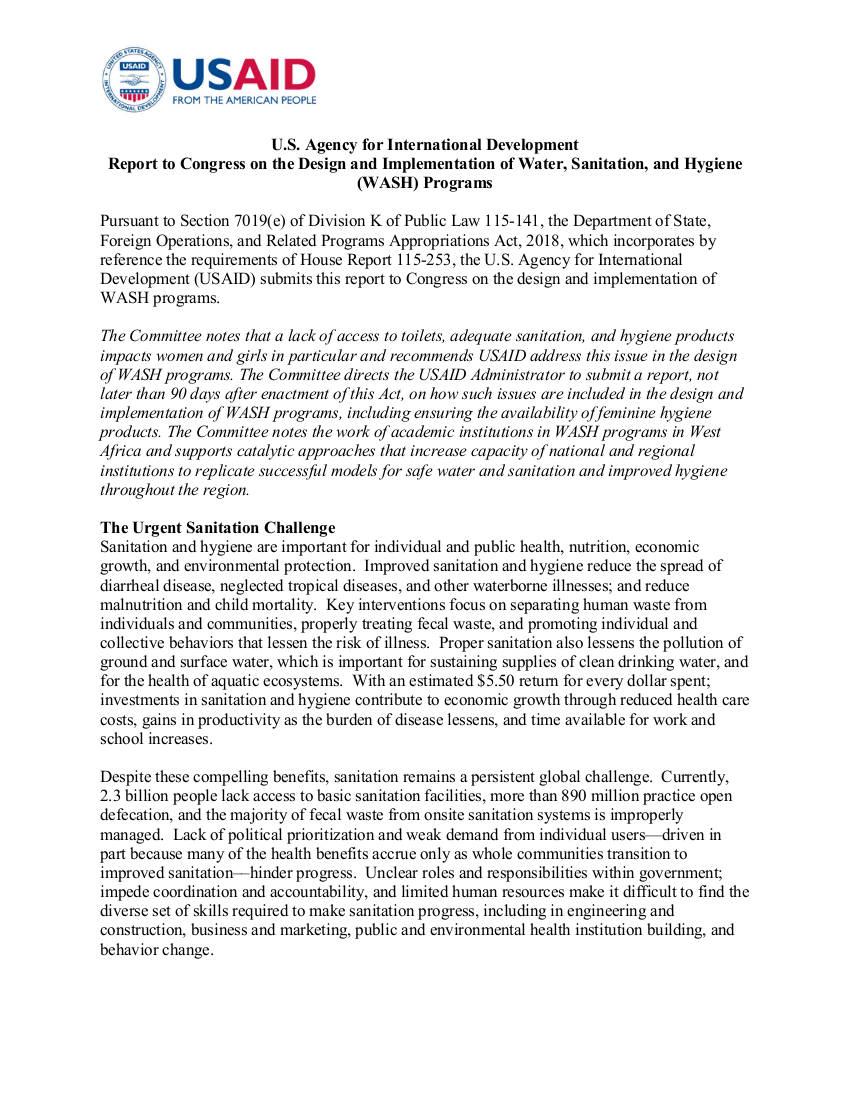Speeches Shim
Pursuant to Section 7019(e) of Division K of Public Law 115-141, the Department of State, Foreign Operations, and Related Programs Appropriations Act, 2018, which incorporates by reference the requirements of House Report 115-253, the U.S. Agency for International Development (USAID) submits this report to Congress on the design and implementation of WASH programs.
The Committee notes that a lack of access to toilets, adequate sanitation, and hygiene products impacts women and girls in particular and recommends USAID address this issue in the design of WASH programs. The Committee directs the USAID Administrator to submit a report, not later than 90 days after enactment of this Act, on how such issues are included in the design and implementation of WASH programs, including ensuring the availability of feminine hygiene products. The Committee notes the work of academic institutions in WASH programs in West Africa and supports catalytic approaches that increase capacity of national and regional institutions to replicate successful models for safe water and sanitation and improved hygiene throughout the region.
The Urgent Sanitation Challenge
Sanitation and hygiene are important for individual and public health, nutrition, economic growth, and environmental protection. Improved sanitation and hygiene reduce the spread of diarrheal disease, neglected tropical diseases, and other waterborne illnesses; and reduce malnutrition and child mortality. Key interventions focus on separating human waste from individuals and communities, properly treating fecal waste, and promoting individual and collective behaviors that lessen the risk of illness. Proper sanitation also lessens the pollution of ground and surface water, which is important for sustaining supplies of clean drinking water, and for the health of aquatic ecosystems. With an estimated $5.50 return for every dollar spent; investments in sanitation and hygiene contribute to economic growth through reduced health care costs, gains in productivity as the burden of disease lessens, and time available for work and school increases.
Despite these compelling benefits, sanitation remains a persistent global challenge. Currently, 2.3 billion people lack access to basic sanitation facilities, more than 890 million practice open defecation, and the majority of fecal waste from onsite sanitation systems is improperly managed. Lack of political prioritization and weak demand from individual users—driven in part because many of the health benefits accrue only as whole communities transition to improved sanitation––hinder progress. Unclear roles and responsibilities within government; impede coordination and accountability, and limited human resources make it difficult to find the diverse set of skills required to make sanitation progress, including in engineering and construction, business and marketing, public and environmental health institution building, and behavior change.
The lack of access to sanitation disproportionately burdens women and girls. They face risks of sexual and physical violence when they have to travel long distances to access sanitation facilities, especially at night; their full engagement in school and work suffers because of a lack of proper facilities to manage menstrual hygiene; and, despite having primary responsibility for caring for children and the elderly who have specialized sanitation needs, do not often have the opportunity to have a voice in sanitation decisions, either at the household or sectoral level.


Comment
Make a general inquiry or suggest an improvement.